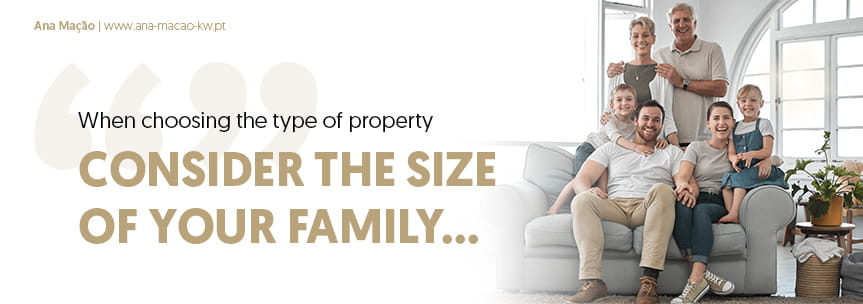Typology
The Typology of a Housing is a classification that defines the type of housing based on the layout, number of rooms, division of areas, among other factors. For example, T3 means: "T" for typology and "3" the number of rooms.
What is a room?(Topãý)
Room is the designation used to identify certain rooms in a house, excluding the kitchen, bathroom and pantry. In other words, bedrooms, living and game rooms, libraries and offices are examples of rooms. The origin of this term is associated with rooms whose flooring is made of wooden flooring.
This designation can sometimes be confusing, especially when compared to terms such as T1, T2, T3, among others. A house with 'n' rooms does not necessarily equate to a T(n) house. Let's see why...
What does the typology T0, T1, T2, T3, T4, T5 or T6 mean? (Topãý)
The characterization of a property often uses the typology called T(n), where 'n' represents the number of rooms in the house . For example, T3 designates a house with three bedrooms and a living room. The remaining rooms, such as kitchens and bathrooms, are not included in this terminology. Alternatively, you can also use the total number of divisions, as is done in the Land Registry. Thus, a T3 will have four divisions: three bedrooms and a living room.

In the case of apartments, the types are: T1 (one bedroom), T2 (two bedrooms), T3 (three bedrooms), T4 (four bedrooms), T5 (five bedrooms), etc. The T0, also known as a 'studio', is an apartment without separate bedrooms, having a single room that serves as a bedroom and living room, as well as a kitchen (usually in kitchenette format) and bathroom.
There is also an alternative nomenclature, such as V1, V2, V3, V4, etc., which is equivalent to T1, T2, T3, T4, etc. This designation was originally associated with 'Villa', a term currently less used and replaced by 'Housing'. This terminology still persists, although it is more common among engineering and architecture professionals than among those who work in the real estate sector.
What are the housing typologies and designations? (Topãý)
In addition to the number of rooms, there are other terminologies that help classify and describe the type of housing. Here are some of the most common housing typologies, accompanied by their particular characteristics.
Apartment
An apartment consists of an individual residential unit that shares common spaces, such as corridors, stairs and elevators, with other condominium owners.

These residential units are often situated in multi-story buildings. It is also common to use the term "floor" to designate the floor on which a specific apartment is located in the building. They are usually found in urban areas, where the cost of land is high and the population density is high. They can vary significantly in structure and size, from simple studios to apartments with three bedrooms or more.
On the other hand, there are apartments with different structures and more than one floor, such as:
Duplex
This designation applies to homes divided into two floors , connected by an internal staircase. Generally, the social area, toilets and kitchen are located on the first floor, while the bedrooms and bathrooms are on the second. They are common in:
- Luxury developments , where the upper floor often adopts a mezzanine format.
- Older buildings that have been remodeled to maximize space.
- Apartments located on the top floor that have been renovated and expanded to take advantage of the attic space.
Triplex
In this category, the property area is distributed over three floors .
Penthouse or Penthouse
These are apartments located on the top floor of a building .These units are highly valued, not only for the absence of neighbors above, but also for the large terraces or outdoor areas that offer panoramic views over the city. Due to their exclusive features, penthouses tend to be more expensive than other apartments in the same building.
Studio
The studio is a compact version of an apartment that combines a living room, bedroom and kitchen in a single space. They are often sought after by singles, students, and young professionals and in Portugal they are also popular for local rentals.
loft
The term ãloftã is a term of Anglo-Saxon origin and designates a type of housing disseminated from the 1950s onwards, which combines a style of design and living (ãLoft Livingã), with decoration and concept. very own housing. It was born in urban areas with a typically industrial matrix, and the property is characterized by double-height ceilings and industrial-style decorative references .They are normally homes adapted from abandoned industrial or commercial spaces, warehouses or other large structures, with few rooms and are characterized by:
- A double or very high ceiling , with the upper floor often used as a mezzanine ;
- Large windows that offer interior environments with lots of light and visibility to the outside;
- Large environments in an open-space style , with few divisions, in which normally only the bedroom(s) have some privacy (or not), with the master bedroom often being located on the mezzanine floor;
- Decoration with reference to industrial elements such as unplastered bricks, cement floors, exposed aluminum piping, etc., etc.
This type of housing began to be used more by artists and creative or liberal professionals, but today its concept has been integrated into the rest of the urban fabric and is successfully used in luxury housing in many cities around the world.
Garden Apartment
It is an apartment with a private garden, usually located on the ground floor of a building. In cities, it is common to find this typology with an incidence in certain neighborhoods, for example in the Alvalade neighborhood, in Lisbon. In more recently constructed buildings, it is a solution that is back in fashion, and its price is higher, due to the garden/leisure area.
Home
A house is a single-family dwelling, that is, a detached house intended to be lived in by a single family. Generally, houses can have one or more floors, have a private garden or backyard, as well as their own parking, and can be built on urban or rural land.
In Portugal, especially in urban areas, houses are considered a type of luxury housing or intended for the upper segment, and are normally more expensive than apartments. Houses are often located in suburban areas of large cities or in areas further away from urban centers.

Detached House or Single Family House
A single-family home is an independent dwelling occupied by a single family. Typically, it has a small garden or yard, as well as a garage. Single-family homes can have one or more floors and offer residents more privacy than other types. Technically, the construction polygon of a detached house has an area of land all around it, which means that the building does not share any walls with neighboring properties. This type of housing is more common in suburban and rural areas than in urban centers.
Townhouse or Townhouse
This designation refers to a house built side by side with two other houses, with which it shares two side walls, but has individual entrances.This typology is quite common in urban areas, where space for isolated buildings is limited.
Semi-detached house
Term used to describe a house built side by side with another. Semi-detached houses usually have similar floor plans and share a common wall. This type of housing is common in suburban areas and stands out in residential neighborhoods, offering a combination of privacy and neighborhood.
Single storey house
It is the term applied to houses that have only one habitable floor. This type of architecture, which was once more common in modest homes, has become rare due to the increase in land prices. Now, it is more common to find houses with 2, 3 and 4 floors, as well as a basement or garage.
Floor House
Normally, it refers to a house that, despite not being divided into land registers, has different floors with independent entrances. Commonly, we are talking about a house with two floors, where one of the houses is on the ground floor and the other on the first floor, with independent access via an external staircase.
Chalet or Mountain House
It is a country house, commonly built in wood or stone and with a sloping roof. This type of housing is popular in rural areas for relaxation or in mountainous areas.
Palace
Name given to a large and luxurious house, with refined architecture and rich in decorative details. These houses tend to have an extensive history and often have many rooms and a large garden or area of land.

Typically, they are the most expensive homes in a city and are often used as corporate headquarters, residences for wealthy families or as boutique hotels.
Solar
It is a country or manor house, usually located in rural areas. It stands out for its noble architecture and history, often associated with nobility or relevant historical figures.

Fifth
Refers to a rural property that includes a house, gardens, cultivation areas and, sometimes, small animal husbandry. It is generally used for agricultural, tourist purposes or as a residence.
In recent decades, farms in Portugal have been redeveloped for various purposes, from rural tourism to short-term accommodation.
Estate
An estate is a large rural property, often used for agricultural, livestock or even tourist purposes.

This type of property is usually composed of areas of cork oak forests and cultivated land. Generally, it has a single-family building located close to the road or access path. The main difference when compared to a farm lies in its size, as it can cover several hectares of land.
How do I choose the ideal housing type for my needs? (Topãý)

Choosing the type of housing that best suits your needs may initially seem like a challenge. However, some practical suggestions can guide you in making an informed decision:
- Consider the size of your family: If you have a large family, the need for a home with multiple bedrooms and common spaces becomes evident. If you live alone or if your children have already left home, perhaps a T2 or T3 would be completely satisfactory.
- Examine your lifestyle: Your daily life can be decisive in choosing the ideal typology. If you work from home, an office space can be crucial. If you enjoy receiving visitors, a large living room and an extra bedroom may be desirable.
- Analyze the available budget: The amount you are willing to invest may limit your options. It is crucial that your budget is aligned with the type of property you want to purchase, not forgetting additional costs such as taxes, maintenance and basic services.
- Study the location: Proximity to services, essential shops and public transport can be a determining factor in your choice.
- Think long term: If you plan to expand your family or welcome elderly relatives in the future, the flexibility of the chosen type can be a critical factor.
- Investigate different options: Expand your search to different areas and neighborhoods to diversify your options and find the home that suits you best.
By considering these factors, you will be better prepared to make the right choice. A well-informed decision can provide long-term benefits, justifying the initial investment of time and effort.
Legislation and housing typology (Topãý)
The term T(n) appears to have its origins in the General Regulation of Urban Buildings, Decree-Law no. 38382, of August 7, 1951, which was later revised by Decree-Law no. 650/75 of 1975 . In this context, we find the following reference:
The type of fire is determined by the number of bedrooms, and the symbol T (index x) is used for its identification, where x represents the number of bedrooms.
Further on (Article 66 -1), a table is presented that clarifies the restrictions imposed on housing compartments, which must meet minimum requirements for number and area.
| ô | Number of compartments and type of fire | ||||||||
| ô | two | 3 | 4 | 5 | 6 | 7 | 8 | More than 8 | |
| ô | T0 | T1 | T2 | T3 | T4 | T5 | T6 | Tn > 6 | |
| Minimum Gross Area (m2) | 35 | 52 | 72 | 91 | 105 | 122 | 134 | ||
| ô | Areas in square meters | ||||||||
| Double room | - | 10.5 | 10.5 | 10.5 | 10.5 | 10.5 | 10.5 | 10.5 | |
| Double room | - | -- | 9 | 9 | 9 | 9 | 9 | } | Remaining rooms of 9m2 |
| Double room | - | -- | -- | 9 | 9 | 9 | 9 | ||
| Double room | - | - | - | - | - | 9 | 9 | ||
| Simple room | - | ô | ô | - | 6.5 | 6.5 | 6.5 | 6.5 | |
| Simple room | - | ô | ô | - | - | - | 6.5 | 6.5 | |
| Living room | 10 | 10 | 12 | 12 | 12 | 16 | 16 | 16 | |
| Kitchen | 6 | 6 | 6 | 6 | 6 | 6 | 6 | 6 | |
| Mandatory area supplement | 6 | 4 | 6 | 8 | 8 | 8 | 10 | (x + 4) m2 (x=number ofbedrooms) |
|
Most frequently asked questions about housing types (Topãý)

For many, the type of housing plays a crucial role in the decision to buy or rent. Here, we clarify some of the most frequently asked questions about the type of housing.
What does the acronym T mean in a property description?
The acronym "T" refers to the total number of rooms in a dwelling. A T2, for example, describes an apartment with two bedrooms.
What is the difference between a house and an apartment?
While a townhouse is an independent dwelling with its own outdoor space, an apartment constitutes a fraction of a shared housing building.
What is a studio?
A studio is a compact housing unit, typically consisting of a single open space that serves as a living area, bedroom and kitchen.
What is the difference between a duplex and a triplex?
What is a penthouse?
A penthouse is a luxury apartment situated on the top floor of a building, often with access to terraces and panoramic views.
What does the acronym RC mean in a property description?
The acronym RC designates the ground floor, which means that the property is located on the ground floor of the building.
What is a T0?
A T0 is a studio that does not have separate rooms, generally being a single space with all the basic functionalities.
What is the difference between a T1 and a T1+1?
A T1 has a bedroom and a living room. A T1+1 has, in addition to the bedroom and living room, an extra room that can function as a second bedroom, office or other functionality. The term "+1" indicates the presence of this additional division, which may vary in characteristics and usefulness.
What is a loft?
A loft is a large space without internal divisions, characterized by a high ceiling. Generally, it is the choice of singles or couples without children, valuing a more open and laid-back lifestyle.
What is a townhouse?
Known in Portugal as a townhouse, a townhouse is a house that shares side walls with other similar houses, but which has its own separate entrance.
Qual ûˋ a diferenûÏa entre casa unifamiliar, bi-familiar e multifamiliar?
Uma casa casa unifamiliar ûˋ um imû°vel destinado û habitaûÏûÈo de apenas uma famûÙlia e geralmente ûˋ construûÙdo num lote de terreno independente, nûÈo partilhando paredes ou espaûÏos comuns com outras unidades habitacionais. Este tipo de casa ûˋ ideal para quem valoriza privacidade e ûˋ muitas vezes associada a moradias tradicionais com jardim ou quintal. O termo "unifamiliar" ûˋ sinû°nimo de "monofamiliar".
Uma habitaûÏûÈo bifamiliar ûˋ um edifûÙcio com duas fraûÏûçes independentes, ideal para acomodar famûÙlias grandes, duas famûÙlias ou para arrendamento. Este tipo de edifûÙcio, tambûˋm conhecido como "casa geminada", possui entradas separadas para cada fraûÏûÈo, o que proporciona privacidade. A estrutura bifamiliar permite a partilha de despesas de manutenûÏûÈo, tornando-a uma opûÏûÈo econû°mica e de suporte mû¤tuo.
In turn, a multi-family house is a building that houses several housing units, with different owners or tenants. This latter type of building is commonly referred to as an apartment block.
What does a semi-detached house mean?
A townhouse is a residential construction where two houses are built side by side, sharing a common wall. The term derives from the Latin "gemini", indicating the symmetry often observed between the houses. Although they share a structure and, sometimes, a roof, each unit has its own separate entrance, garden and garage, guaranteeing a certain independence between residents.
How many rooms does a T1, T2, T3 or T4 have?
A T1 has two rooms, a T2 has three rooms, a T3 has four rooms, and a T4 has five rooms. These rooms include the bedrooms and living rooms, but exclude the kitchen, bathrooms and pantry. The Typology of a Housing serves to designate the number of rooms in a house, as well as the structure and division of areas. In other words, "T" means typology and "1,2,3,4" means the number of rooms.
What is the difference between T2 and V2, T3 and V3, or T4 and V4?
The letter "T" in the typologies refers to apartments, while the letter "V" refers to houses or villas.For example, T2 indicates an apartment with two rooms, while V2 indicates a house or villa with two rooms.





